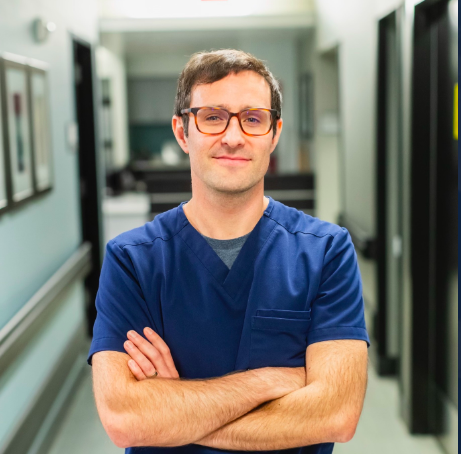Radiologist ponders: ‘If private practice is so great, why are so many groups struggling?’
A Texas radiologist and writer is pondering: “If private practice is so great, why are so many groups struggling?”
Ben White, MD—with American Radiology Associates, an academic imaging group in Dallas—recently posed the question on his blog, BenWhite.com. Data on this trend has raised alarm among members of the specialty, who believe preserving independent practice is essential to radiology’s future.
The number of radiologists in private practice fell below 50% in 2023 for the first time since the American Medical Association started tracking these figures in 2012 (when it was 63.6%). AMA cited likely reasons including economic stress, fiscal uncertainty, rising costs, and payment cuts in Medicare.
Nearly 80% of all physicians now work for hospitals, health systems or other corporate entities such as insurers or private equity firms, the Physicians Advocacy Institute estimated last year. Another 2024 analysis noted that, between 2015 and 2022, nearly 3,500 physician practices that provide radiology services disappeared from the Medicare Provider Data Log—absorbed by others or left out of business.
“Because it’s hard,” White wrote Feb. 3 in response to his own question. “I believe that private practice is important. It provides an anchor for how doctors are paid and establishes standards for how a specialty chooses to practice. When employed positions are good, that is largely a direct result of the need to compete with private practice in a tight labor market. However, it does not necessarily follow that all or even most practices are run well.”
White offered five possible reasons why some private practices are struggling to stay afloat in 2025. In brief:
1. Instability is everywhere: Staffing challenges and shifting lifestyle demands—such as the desire to focus on one subspecialty, work from home, avoid nights and weekends, etc.—have destabilized practices. “I think the shortage has absolutely shredded some democratic groups, especially those that are small with a lot of physical presence, call, or struggling to staff women’s imaging.”
2. Everything is local: If a hospital is playing hard ball in rate negotiations, practices may not have what they need for recruitment and retention. Hospitals also have the leeway to supplement compensation with stipends and a portion of technical fees, allowing them to offer a “better job” than physician groups relying on professional fees alone. “They could give that support to a private practice so that the group is healthy, or if they are more daring, they can be aggressive and use that as leverage to bring the group in-house.”

3. The tele problem: If a private practice can’t recruit to an undesirable community, they likely need to rely on teleradiologists. However, in today’s market, they’re competing nationally, rather than locally, to hire this help. “The more people who want to do teleradiology, the more groups struggle to sustainably get the work done locally. So, we can just say it: People’s individual desires are destabilizing the field. It may be reasonable for the individual and their family but no doubt it’s a growing problem for local, high-touch practices. It also makes it easier for rads to quit their jobs for any reason and find work without having to make geographic changes.”
4. Consolidation is real: Size does matter, White noted, with larger radiology groups harder to replace, able to provide more remote work options, higher pay, etc. “A fragmented market with many small groups in the current era of big, consolidated health networks, payer shenanigans, CMS cuts, and stupid MIPS compliance measures is less predictable than one with a few big groups that are busy enough that they really aren’t competing with each other so much as holding a line against the hospitals.”
5. Risk and opportunities: Imaging volumes continue to rise, with some hospitals and other entities struggling to respond. This presents an opportunity for private practices, but also real risk and the stress and struggles that come with it. “I don’t think this is a simple time to be a radiologist or to run a practice, but I think the real existential difference between private practice and other models is that the hospital can get locums or pay extra for a different group if they are forced to, but an independent practice fails when it fails. There is no alternative: It either works or it doesn’t,” White wrote.
His piece had garnered several responses on social media and his blog as of Thursday.
“Private practice is not great unless you can negotiate,” wrote Louisville, Kentucky, radiologist Jon Myers, DO. “If groups aren’t getting a stipend from a hospital that is expecting you to break your backs administering/servicing their depts. for free…you will not be competitive. Working tele locums is highly lucrative currently.”
“Managing a practice (which is a business) is a completely different skill set than being a doctor/clinician,” added Kent Thomas, founder and chief operating officer of Yellowcross Healthcare, a teleradiology group that launched last year. “It has been said, ‘You can have profits or patient care, but not both.’ We're continually at conflict with our goals. Additionally, if you don't actively manage your business (practice), it will manage itself, often to outcomes other than intended. Unfortunately, I have seen this far more often than not.”
“It has to do with staffing shortages because the model has extracted much of the revenues/profits from the older generations that got paid VERY well and are still hanging on, with less to worry about overall, but now with increasing demands to boot,” one anonymous blog reader responded. “That can’t work for younger rads who have to pay more in literally every way. The hospitals took a ton of the payment FROM PP and now are having to face up to the fact that their golden run of the last 15 years finally is blowing up in their face. It’s funny how they act like they haven’t been making $ hand over fist while stealing the technical via lobbying, etc.”
You can read much more on White’s blog and find him on Twitter and LinkedIn. We also previously profiled his independent job board that launched last year.

